

Simulistics Ltd.
2B Pentland Park
Loanhead, Midlothian
EH20 9PA
Scotland, United Kingdom
Email: info@simulistics.com
Introduction
Downloads
Support
Clubs
About Us
Simulating Pastoral Livelihoods
Draft summary of the use of SIMILE in livelihoods research in Ethiopia
J. M. Davies, University of Reading, 31/05/2004.
This application of SIMILE does not have a specially formulated name or acronymic label since the project was using systems modelling to analyse broad-based livelihoods data rather than attempting to develop a model for wider application. The intention was to examine the feasibility of using a systems modelling approach for unique individual studies and to develop a more rigorous analysis of broad-based, ‘participatory’ type data – the kind of data that is gathered in abundance through livelihoods research but which is seldom given more than a descriptive analysis. Hereafter the model is referred to as the Pastoral Livelihoods Model.
SIMILE was used, along with other types of software (such as statistical and spreadsheet packages), to analyse data gathered through a livelihoods research project in the Afar region of Ethiopia. The research project accumulated data from questionnaire surveys, market monitoring, informal interviews plus an array of ‘RRA’ (Rapid Rural Appraisal) tools, many of which were designed specifically for the research. SIMILE was applied to draw together data on livestock productivity, food security and market trends to simulate livelihood trajectories and outcomes under a range of scenarios, and to test the implications of sectoral interventions on the wider livelihood.
The Afar region of Ethiopia is home to the Afar people, the vast majority of whom are transhumant pastoralists whose livelihoods are characterised by extreme climatic uncertainty. The research focused on central Afar where livelihoods are constructed almost entirely around extensive livestock production, where low rainfall (averaging 180 mm per year) renders agriculture impossible and where alternative livelihood strategies are very limited. This document will not attempt further justification of methodology and sampling and the population was explicitly selected for a certain lack of livelihoods diversity in the hope that this would facilitate an improved understanding of the core livelihood strategy – namely pastoralism.
SIMILE was chosen for this research for a number of reasons, and although the software’s stated role is in supporting “ecological, biological and environmental research” it has a number of features that made it an appropriate choice of systems tool for this study:
ease of operation – given that the justification for the approach was to explore the applicability of systems modelling as a general analytical tool, the software needed to be as user-friendly as possible;
simplicity in the modelling of individuals within populations was particularly suited to construction of complex herd structures, as was the ease of splitting models into sub-classes according to age, sex etc;
facility of interfacing additional submodels was important given the scope of livelihoods research and the ‘organic’ nature of the analysis – the construction of the model was itself an important step in the analytical process and it therefore the construction process needed to be sufficiently flexible to allow rapid changes and evolutions as the model was assembled
the complexity of livelihoods ensures that there is a never-ending range of options for extending or applying the core model – the flexibility that comes with the simplicity of interfacing new submodels in SIMILE means that cross-sectoral and interdisciplinary research efforts could be easily linked using the software;
the simplicity of ‘wrapping’ the modelling to provide multiple iterations of a given scenario allowed the extensive and thorough testing of stochastic parameters that was required to model uncertainty and vulnerability within the livelihood.
Overview of the Pastoral Livelihoods Model
The Pastoral Livelihoods Model consisted of three key submodels: herd, household and market. The herd submodel was further divided into four species (cattle, camels, sheep and goats) and each species submodel was further divided into male and female populations. This level of detail was considered appropriate given the seasonal differences in milk output, reproduction rates and mortality and because it allowed comparison of herd structures according to wealth – in Afar, wealthier households tend to own a greater proportion (as well as a greater number) of large, relatively high-yielding, but slow-reproducing stock. A fourth submodel, not detailed further here, was constructed to gather the different model outputs (food surpluses and deficits, cash income surpluses, livestock ‘surpluses’) for the sake of simplified valuation, according to prevailing market prices, of livelihood trajectories (asset and income growth).
The model ran in monthly time steps and included a number of seasonal factors that enabled simulation of the bi-modal rainfall pattern of the Afar region. In the case of many parameters, a probabilistic dimension was included to provide a realistic distribution of events around an observed mean.
Female herd submodels
Using SIMILE’s population submodel feature, individual females are modelled with a number of stochastic parameters and multiple instances of the individual are created as directed. Reproduction leads to an increase in the number of instances and death or out-migration leads to a decrease in the number. Thus any stochastic or periodic steps are calculated on an individual-animal basis.
The number of females in the herd is input at the start of the model run and the starting herd dynamic is randomised to remove the need for running a stabilisation period. Data on herd profiles – i.e. age and sex structure of different herds – was used to build stabilised starting populations by using weighted random assignation of starting condition (mature/immature, pregnant/lactating/dry etc.) to give a mean representation of real herd dynamics. All subsequent herd additions start life at 0 months.
During the life cycle of each female, rules are imposed, based on further field data, to control reproduction. Sexual maturity is reached at a pre-determined age and thereafter there is a probabilistic monthly chance of birth, estimated from data on calving intervals and following a seasonal pattern, with higher birth rates in the appropriate months of the year.
Milk output is determined according to the length of time since the last birth and also the time of year; i.e. there is a seasonal dimension and a physiological dimension. Because the month of birth is also seasonally determined, there is a dual seasonal effect expressed on herd milk yields which replicates observed production patterns. After the minimum birth interval for the species has been exceeded, the random monthly chance of birth applies again.
Example of a female herd submodel
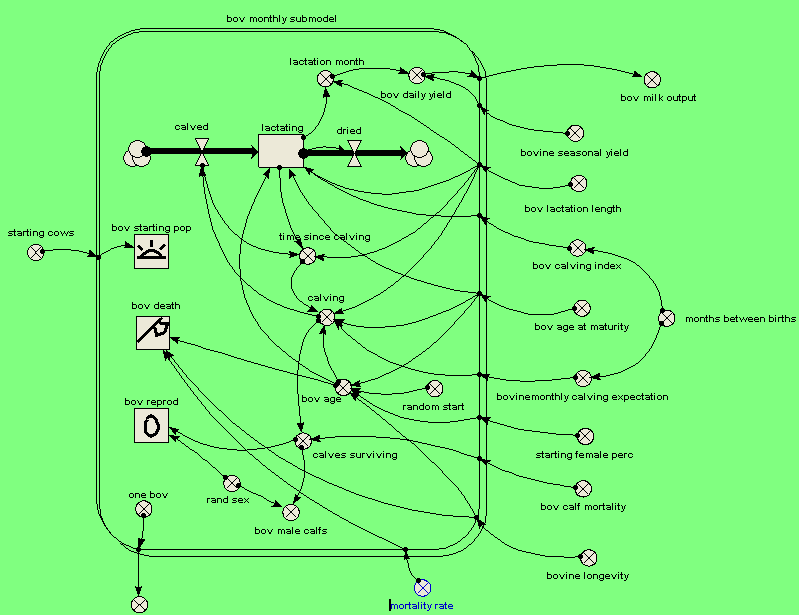
There is a probabilistic monthly chance of mortality for adults, up to a fixed upper age limit, and also a random chance of mortality at birth (simulating all young mortality). At death all females are removed from the herd and no further income is generated.
At birth all male stock are modelled in a separate ‘male submodel’ whereas all new female stock augment the core herd unit.
Male submodels
The male submodel is comparatively simple; males that exist when the model run commences are assigned a starting age based on field-observations of herd structures, males that are subsequently born augment the male submodel and all members are subject to monthly a probability of mortality (male calves are subject to the afore-mentioned young-mortality rate before they join the male submodel).
The only exceptional feature is the construction of a ‘relation submodel’ which enables ranking of individual members in order to facilitate the modelling of livestock sales. When sales of livestock occur, members are removed from the male submodel in rank-order, which is related to the animal’s age. Males are thus sold in order of age and in preference to females, which are two necessary simplifications that may differ importantly from the real-world scenario.
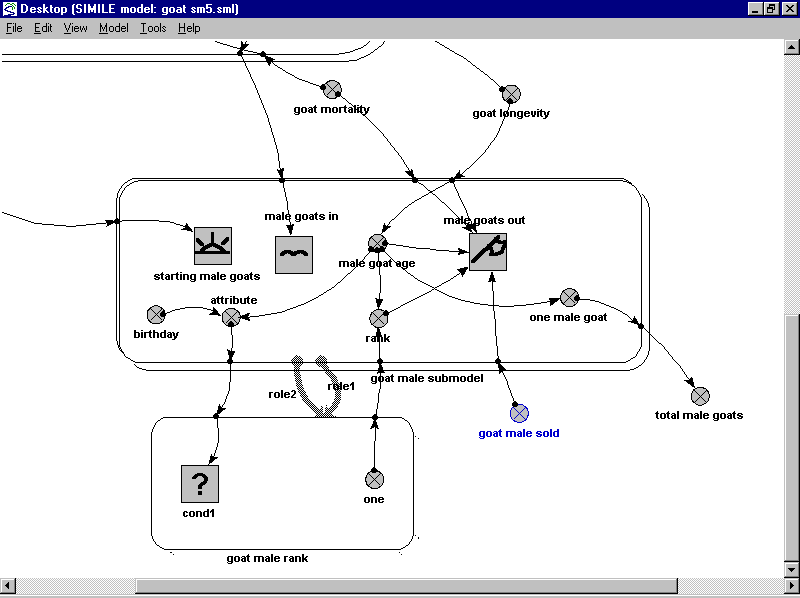
Example
of a male herd submodel
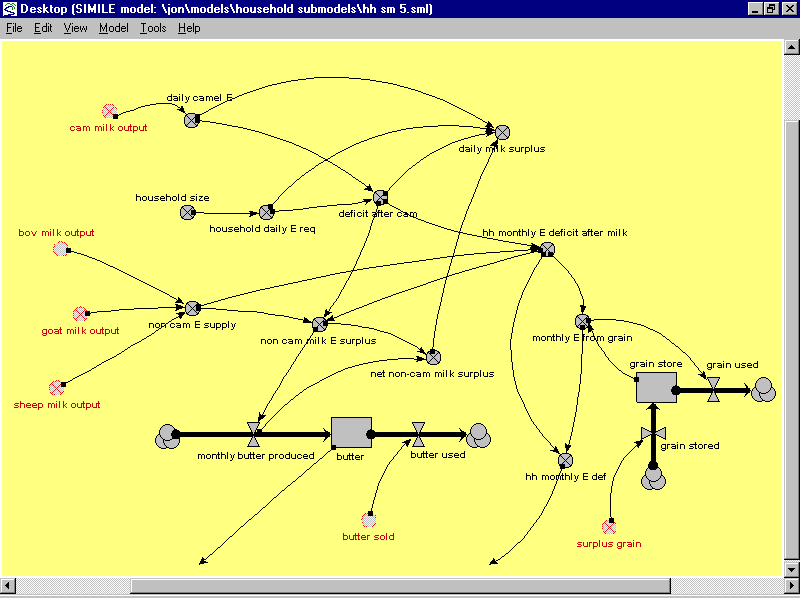
Household submodel
The core of the Pastoral Livelihoods Model is the household unit where food energy demand and supply are monitored and capital assets management is determined. All herd milk outputs are fed into the household submodel (milk sale in central Afar is unheard of) and all grain purchases are determined according to monthly food energy deficits. Milk that is surplus to immediate requirement is processed into butter, up to a limit that is determined by labour availability, and stored in the household for subsequent sale.
When the household submodel yields a monthly energy deficit after milk consumption it activates the market submodel to simulate the sale of either butter or male stock, enabling grain to be purchased to satisfy the household energy demand. A “grain-store” component is included to reflect the fact that grain may be purchased in excess of immediate (monthly) requirement, although there are tight limits on the quantity that can be stored, determined by transportation and storage constraints. Purchased maize can thus be retained for consumption when the household submodel next records a monthly energy deficit.
Market submodel
The market submodel receives a demand for energy from the household submodel when milk supply to the household is insufficient and grain is required. If butter is available it is sold first and thereafter the male livestock are ordered in a hierarchy to allow their sale in order to allow purchase of grain. Terms of trade are determined using market data gathered during 2001-2002 and follow the observed monthly pattern (data is input for a normal year and then adjusted as necessary to simulate market changes during drought).
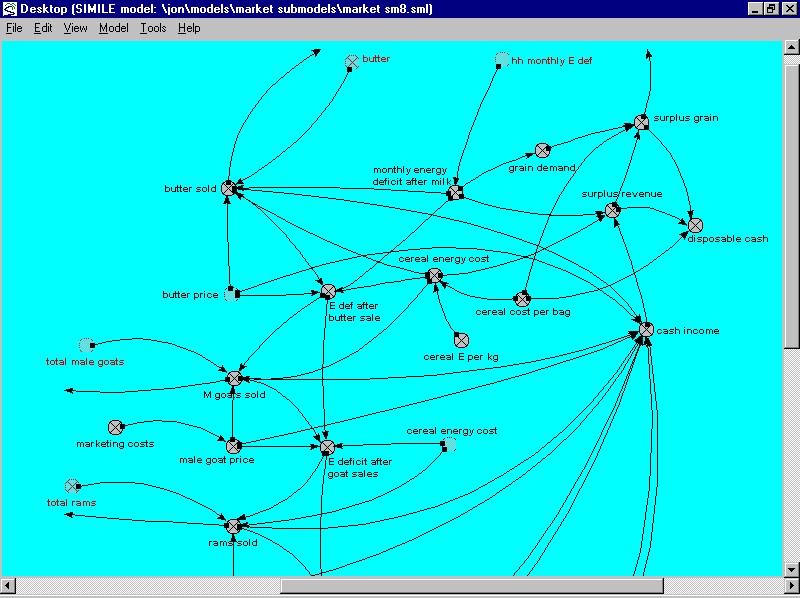
Section of the market submodel
The market submodel therefore receives information on the monthly availability of stock for sale and the monthly value of that stock in terms of grain energy purchasable. When faced with energy demand, the market submodel sells each commodity (butter or livestock) according to their position in a hierarchy, exhausting all of one commodity before starting the sale of the next – this is a further necessary simplification that differs from the real-world scenario, in which herders may exercise free choice over which species they sell at any given time. This hierarchical approach is simplified as follows;
If total Energy that can be purchased through the sale of commodity X exceeds demand then sufficient X is sold to meet demand;
If total Energy that can be purchased through the sale of commodity X falls short of demand then all X is sold and an energy deficit is returned to the next commodity in the hierarchy.
The market submodel includes a parameter for marketing costs, designed to simulate observable transaction costs, which vary according to the scenario being modelled. The model also records a value for cash that is generated in excess of that which can be spent on grain (a decision based on certain observed rules) which can be used to simulate the liquidity problems of selling livestock. The market submodel therefore provides an output for surplus cash generated, an output for energy returned to the household and an output for energy deficit in a month when there is insufficient livestock available for sale to allow energy demand to be satisfied.
Application of the Pastoral Livelihoods Model
Testing raw data
One of the aims of constructing the Pastoral Livelihoods Model was to validate data gathered through participatory-style field studies. Simulated population growth rates and milk yields were compared with a wide range of literary figures to give an indication of the accuracy of the data collection techniques and of the model itself, forming a process of model validation. This validation process was also used to ensure that herd structures did not change on average over time, ensuring that the objective of creating a stabilised starting population had been achieved.
Modelling Livelihood Outcomes
Using data gathered during both ‘normal’ (optimal) and drought periods, the model was used to provide comparison of asset growth, income sufficiency and uncertainty between different wealth groups. Tests were typically conducted over a twelve month period using households constructed according to three wealth categories (rich, poor, average). The tests examined annual milk surpluses, periods of the year when milk surplus was not achieved, months when energy deficits were recorded, size and value (in terms of prevailing grain energy prices) of energy deficits, annual cash income per capita, cash surpluses and size (and direction) of asset growth.
As the following graph illustrates, the model provided informative insights into not only the magnitude of outcomes for households in different wealth groups, but also the spread of those outcomes, indicating the greater extent of uncertainty associated with poverty. The model proves particularly useful for exploring the dynamics of poverty, the extent of uncertainty that comes with relative poverty and the degree of vulnerability to specific shocks that face households of different asset wealth.
Example of change in asset value during optimal year1
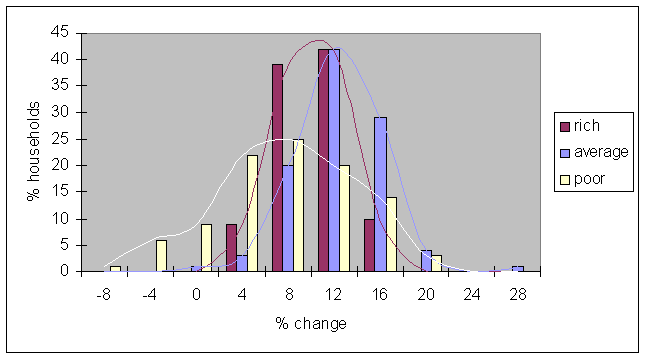
To model a drought shock, the parameters for livestock mortality, reproductive performance, milk yield and terms of trade were adjusted according to observed impacts and the livelihood outcomes were compared with those in the normal year. The impacts were included stepwise to allow comparison of individual impacts and of combined impacts of changes. The cumulative impact of the different livestock-related effects of drought combined with the amplifying impact of deteriorating terms of trade led to dramatic outcomes when the full-blown drought was modelled.
The preceding chart illustrates how deterioration of individual parameters leads to an increased spread of outcomes according to household wealth. This increasing distribution of outcomes around the group mean can be equated with the degree of uncertainty that is associated with poverty.
Simulating Interventions
Tests were conducted to examine the changing livelihood outcomes in response to improvements of certain model conditions, simulating the impact of development interventions. Two scenarios were constructed, representing livestock (veterinary) interventions and market (grain price) interventions. All tests were conducted on all wealth groups during normal and drought years to examine the different effects under different circumstances.
‘Livestock interventions’ focused on both reduced mortality rates and improved reproduction and milk yields, using data gathered from program evaluations in a number of developing countries. Two livelihood outcomes were prioritised for comparison: asset depletion/growth and cash shortfall (providing a food energy deficit valuation).
‘Market interventions’ simulated the impact of stabilising grain prices on food security in drought and non-drought years. Prices were fixed at above-mean-value to imply a tangible cost of intervention and positive impacts during drought were compared with negative impacts during good years.
The tests on potential interventions and policies indicate that the livelihoods model has useful applications in examining ‘livelihood outcomes’. Rather than focussing solely on the sectoral impact of a given intervention, such as the impact of vaccination on livestock mortality, the simulations enable the wider impact of the intervention to be examined on food security and household vulnerability (measured in terms of the distribution of livelihood outcomes).
Future application and development of the Pastoral Livelihoods Model
On one level there was no intention of constructing the Pastoral Livelihoods Model with the view to a prolonged process of development and improvement – the primary aim was always to analyse a rather extensive array of data as incisively as possible. The most interesting judgement to make is therefore regarding the applicability of such an approach and the relevance of keeping a systems modelling programme as one of a number of analytical weapons in the researcher’s armoury for routine employment (as opposed to reserving it for specialist systems-modelling projects).
This research illustrates that a great deal can be made of relatively disparate data that is both quantitative and qualitative, but the process of modelling can be rather elaborate. This is not necessarily a criticism and the process and the discipline of model construction can be highly informative, indeed perhaps more informative than the eventual simulations, allowing more to be learned from livelihoods studies than is currently, typically achieved. The extensiveness of the modelling process, however, could be greatly improved if a set of rules, guidelines or protocols could be established that translated best-practice into layman’s terms. Systems modelling tends to be cloaked in rather obscure mathematical reasoning that is somewhat inaccessible and, whilst SIMILE’s facility of use goes some way to de-mystifying the process, more is needed if systems-modelling is to be made into a layman’s tool. This research illustrates that this could be a desirable goal.
The Pastoral Livelihoods Model has many avenues for further exploration and if it were to be used again, or adapted, certain additional aspects might be worth considering. Above all there is a demand for greater modelling of household labour and greater sophistication of the household submodel. Labour is central to every household’s livelihood and modelling labour would be particularly consistent with the aims of the Sustainable Livelihoods Framework (i.e. putting people at the centre of research). In this model there is scope for modelling the impact of household labour division on herd productivity, marketing ability, household energy demand and adoption of alternative incomes, to name a few of the obvious opportunities. A few key labour parameters could be relatively simply modelled, allowing examination of the impact of human-capital-building interventions.
A further area where the Pastoral Livelihoods Model might be developed is in exploring environmental constraints and impacts on the livelihood. This has been achieved clumsily through the modelling of a drought, but this is a very one-off and static type of shock. The introduction of an environmental submodel could be highly useful in exploring the dynamic nature of shocks and the different impacts of a range of escalating shocks – something that might be more consistent with the original design-objectives of the software. This addition would be of particular interest in expanding the understanding of uncertainty, and hence vulnerability, in pastoral and other livelihoods.
1 All tests performed using the Pastoral Livelihoods Model were conducted 100 times for each household.
Draft summary of the use of SIMILE in livelihoods research in Ethiopia
J. M. Davies, University of Reading, 31/05/2004.
© 2002, 2004 Simulistics Ltd
